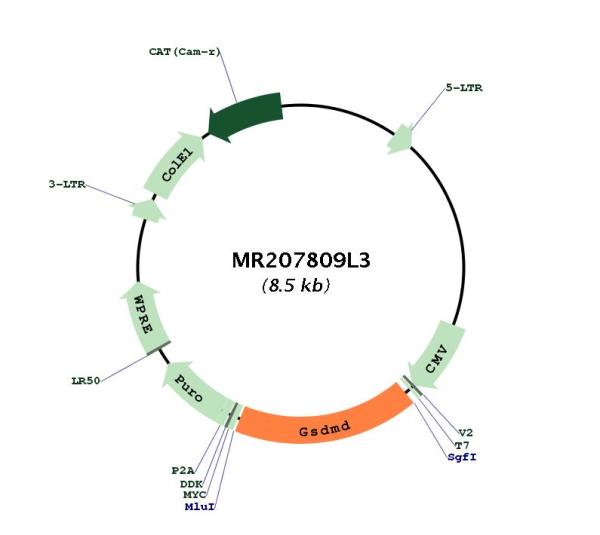Gsdmd (NM_026960) Mouse Tagged Lenti ORF Clone
CAT#: MR207809L3
- LentiORF®
Lenti ORF clone of Gsdmd (Myc-DDK-tagged) - Mouse gasdermin D (Gsdmd)
"NM_026960" in other vectors (4)
Interest in protein/lysate? Submit request here!
Specifications
| Product Data | |
| Type | Mouse Tagged ORF Clone |
| Tag | Myc-DDK |
| Symbol | Gsdmd |
| Synonyms | 1810036L03Rik; AW558049; DF5L; Dfna5l; Gsdmdc1; M2-4 |
| Vector | pLenti-C-Myc-DDK-P2A-Puro |
| E. coli Selection | Chloramphenicol (34 ug/mL) |
| Mammalian Cell Selection | Puromycin |
| Sequence Data |
The ORF insert of this clone is exactly the same as(MR207809).
|
| Restriction Sites |
SgfI-MluI
Cloning Scheme for this gene
Plasmid Map

|
| ACCN | NM_026960 |
| ORF Size | 1464 bp |
| OTI Disclaimer | Due to the inherent nature of this plasmid, standard methods to replicate additional amounts of DNA in E. coli are highly likely to result in mutations and/or rearrangements. Therefore, OriGene does not guarantee the capability to replicate this plasmid DNA. Additional amounts of DNA can be purchased from OriGene with batch-specific, full-sequence verification at a reduced cost. Please contact our customer care team at custsupport@origene.com or by calling 301.340.3188 option 3 for pricing and delivery. The molecular sequence of this clone aligns with the gene accession number as a point of reference only. However, individual transcript sequences of the same gene can differ through naturally occurring variations (e.g. polymorphisms), each with its own valid existence. This clone is substantially in agreement with the reference, but a complete review of all prevailing variants is recommended prior to use. More info |
| OTI Annotation | This clone was engineered to express the complete ORF with an expression tag. Expression varies depending on the nature of the gene. |
| Product Components | The ORF clone is ion-exchange column purified and shipped in a 2D barcoded Matrix tube containing 10ug of transfection-ready, dried plasmid DNA (reconstitute with 100 ul of water). |
| Reconstitution | 1. Centrifuge at 5,000xg for 5min. 2. Carefully open the tube and add 100ul of sterile water to dissolve the DNA. 3. Close the tube and incubate for 10 minutes at room temperature. 4. Briefly vortex the tube and then do a quick spin (less than 5000xg) to concentrate the liquid at the bottom. 5. Store the suspended plasmid at -20°C. The DNA is stable for at least one year from date of shipping when stored at -20°C. |
| Reference Data | |
| RefSeq | NM_026960.1 |
| RefSeq Size | 1776 bp |
| RefSeq ORF | 1464 bp |
| Locus ID | 69146 |
| UniProt ID | Q9D8T2 |
| Cytogenetics | 15 D3 |
| Gene Summary | Gasdermin-D, N-terminal: Promotes pyroptosis in response to microbial infection and danger signals. Produced by the cleavage of gasdermin-D by inflammatory caspases CASP1 or CASP4 in response to canonical, as well as non-canonical (such as cytosolic LPS) inflammasome activators (PubMed:26611636, PubMed:26375259, PubMed:26375003, PubMed:27418190, PubMed:27385778, PubMed:27383986). After cleavage, moves to the plasma membrane where it strongly binds to membrane inner leaflet lipids, including monophosphorylated phosphatidylinositols, such as phosphatidylinositol 4-phosphate, bisphosphorylated phosphatidylinositols, such as phosphatidylinositol (4,5)-bisphosphate, as well as phosphatidylinositol (3,4,5)-trisphosphate, and more weakly to phosphatidic acid and phosphatidylserine. Homooligomerizes within the membrane and forms pores of 10 - 15 nanometers (nm) of inner diameter, allowing the release of mature IL1B and triggering pyroptosis. Exhibits bactericidal activity. Gasdermin-D, N-terminal released from pyroptotic cells into the extracellular milieu rapidly binds to and kills both Gram-negative and Gram-positive bacteria, without harming neighboring mammalian cells, as it does not disrupt the plasma membrane from the outside due to lipid-binding specificity. Under cell culture conditions, also active against intracellular bacteria, such as Listeria monocytogenes. Strongly binds to bacterial and mitochondrial lipids, including cardiolipin. Does not bind to phosphatidylethanolamine or phosphatidylcholine (PubMed:27383986).[UniProtKB/Swiss-Prot Function] |
Documents
| Product Manuals |
| FAQs |
| SDS |
Resources
Other Versions
| SKU | Description | Size | Price |
|---|---|---|---|
| MC202215 | Gsdmd (untagged) - Mouse gasdermin D (Gsdmd), (10ug) |
USD 686.00 |
|
| MG207809 | Gsdmd (tGFP-tagged) - Mouse gasdermin domain containing 1 (Gsdmdc1) |
USD 886.00 |
|
| MR207809 | Gsdmd (Myc-DDK-tagged) - Mouse gasdermin D (Gsdmd) |
USD 686.00 |
|
| MR207809L4 | Lenti ORF clone of Gsdmd (mGFP-tagged) - Mouse gasdermin D (Gsdmd) |
USD 986.00 |
{0} Product Review(s)
Be the first one to submit a review






























































































































































































































































 Germany
Germany
 Japan
Japan
 United Kingdom
United Kingdom
 China
China


